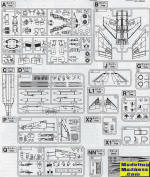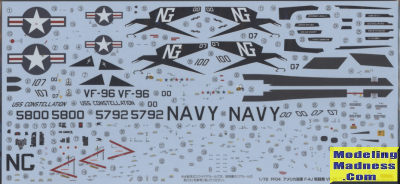
Fine Molds 1/72 F-4J "VF-96 Showtime 100"
| KIT #: | FF04 |
| PRICE: | 5971 yen delivered from Japan (~$40.00) |
| DECALS: | Two options |
| REVIEWER: | Scott Van Aken |
| NOTES: | 2024 release |

| HISTORY |
The McDonnell Douglas F-4 Phantom II is an American tandem two-seat, twin-engine, all-weather, long-range supersonic jet interceptor and fighter-bomber originally developed by McDonnell Aircraft for the United States Navy. Proving highly adaptable, it entered service with the Navy in 1961 before it was adopted by the United States Marine Corps and the United States Air Force, and by the mid-1960s it had become a major part of their air arms. Phantom production ran from 1958 to 1981 with a total of 5,195 aircraft built, making it the most produced American supersonic military aircraft in history, and cementing its position as a signature combat aircraft of the Cold War.
The success of the Navy's F-4B ensured its continued operation by the USN. As with all modern or near modern aircraft, the airframe was improved over time. For the Navy it meant adopting more powerful engines, improved avionics and a change to wider, lower pressure tires as on USAF versions. It also meant the addition of DECM antennas on the sides of the intakes later in the type's development. This improved version was the F-4J which was later modified even more to the F-4S, the last USN variant. This kit is of the earlier F-4J wihout the DECM antennas as operated during the Vietnam War.
| THE KIT |
 Fine Molds has turned their expertise to the F-4
Phantom II. Initial releases were of the Japanese F-4EJ, however, since then
they have covered most of the other US variants save for the B/N, S, RF
versions, and G. I doubt those will be too far away as the F-4 is too lucrative
a subject to ignore. I'm sure it will
only be a matter of time before they tackle the others as the kit is quite
modular. Another thing they have done is to limit the markings options in many
of their boxings, choosing to concentrate on multiple aircraft from the same
squadron, as is the case for this kit. Doing this widens the number of reboxings
that can be done.
Fine Molds has turned their expertise to the F-4
Phantom II. Initial releases were of the Japanese F-4EJ, however, since then
they have covered most of the other US variants save for the B/N, S, RF
versions, and G. I doubt those will be too far away as the F-4 is too lucrative
a subject to ignore. I'm sure it will
only be a matter of time before they tackle the others as the kit is quite
modular. Another thing they have done is to limit the markings options in many
of their boxings, choosing to concentrate on multiple aircraft from the same
squadron, as is the case for this kit. Doing this widens the number of reboxings
that can be done.
Here are some of the interesting features. In the cockpit, the side consoles are separate inserts to take into account the differences between variants. Fine Molds has also taken into consideration the difference in back seat layouts for the Navy version; at least to some extent. By that I mean there is no half console on the left side nor is there a steering control for the radar system. There is full intake trunking back to the first compressor stages. Not surprising is that the forward fuselage is separate. The main fuselage is a single piece with an upper deck insert so no worries about seams. There is also a detail piece for the engine aux intake doors.
Wings are a lower section that includes most of the lower fuselage with upper halves and separate wing tips. There is no folding wing option with this kit. This kit has the 'hard wing' that was typical of the variant. The wing underside has inserts for where the cat attachment points would be on the naval versions.
The metal portion of the rear fuselage is a separate item with an insert for the very aft portion. Again, to eliminate some of the usual seams one sees in other kits. You are provided only the fin that is appropriate to the J version. Horizontal stabs are interlocking to help with alignment. This kit provides an unreinforced slotted version that was installed late in F-4B production to improve low speed handling.
Inner main gear doors include a portion of the gear well so attaching these will be a breeze. You are provided missile pylons and three drop tanks. However, there are no weapons, those being offered in a separate weapons pack or you can get those from the spares bin or other sources. Finally, you can do canopy open or closed with a separate closed canopy piece.
 Instructions
are in booklet form and are excellent, providing Gunze and FS 595 color
references. Two nearly identical options are provided. Both are in matte light
gull grey over gloss white. The gloss lgg did not come into use until late 1972.
Markings are for the box art plane which was lost during Cunningham and
Driscoll's epic battle in May 1972. The other is a plane that was assigned to
Cunningham during this time period. The superbly
printed decal sheet includes the expected mass of stencils and also has decals
for the instrument and console panels. A nice touch is the black trim
around the canopy is part of the sheet.
Instructions
are in booklet form and are excellent, providing Gunze and FS 595 color
references. Two nearly identical options are provided. Both are in matte light
gull grey over gloss white. The gloss lgg did not come into use until late 1972.
Markings are for the box art plane which was lost during Cunningham and
Driscoll's epic battle in May 1972. The other is a plane that was assigned to
Cunningham during this time period. The superbly
printed decal sheet includes the expected mass of stencils and also has decals
for the instrument and console panels. A nice touch is the black trim
around the canopy is part of the sheet.
| CONCLUSIONS |
These are really very nice kits. I have so far, built one, the F-4D and while it was a little fiddly at times, built into a very nice model. These are undoubtedly the best in this scale, specifically due to their engineering. It does not mean that other, older F-4 kits are junk, just that this has kicked things up a notch.
| REFERENCES |
https://en.wikipedia.org/wiki/McDonnell_Douglas_F-4_Phantom_II
October 2024 Copyright ModelingMadness.com. All rights reserved. No
reproduction in part or in whole without express permission from the editor.
If you would like your product reviewed fairly and fairly quickly, please
contact
the editor or see other details in the
Note to
Contributors.